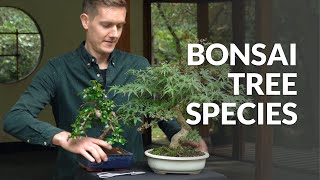Myrtle Bonsai Care guidelines
The myrtle can be kept indoors but it needs a lot of light and air. It prefers a place in semi-shade outside during the hot summer. In autumn the tree should be taken into a cool room with temperatures around 50°F / 10° C and placed at a window facing south or under grow lights.
Keep the rootball moist, never let it dry out completely, but also avoid excess soil wetness. Drying out will kill the tree immediately. Use rain water if possible, because the myrtle does not like high concentrations of lime. Continue reading about watering Bonsai trees.
Watering
Free lecture from the Beginners CourseUse a liquid fertilizer every week during the growing season. Don't fertilize in winter when the tree is kept in a cool room. If the winter location is warmer than 50°F / 10° C and the tree continues to grow a little, fertilize twice a month.
After flowering let the new shoots grow until they have produced 6 to 8 pairs of leaves before you cut them back. When the myrtle is trimmed, take care that a pair of leaves remains on every twig to ensure new buds will be produced. The myrtle ramifies very well. Use cut paste on larger cut wounds. Wiring is possible on young shoots and twigs but older branches are stiff and break easily. Continue reading about pruning Bonsai trees.
Repot younger myrtles every two or three years and older specimens every three to five years because they produce more flowers when they get a little rootbound. The soil mix must be lime-free. You can add some peat or Kanuma to your normal soil mix. Continue reading about repotting Bonsai trees.
The myrtle Bonsai can be propagated from seeds and cuttings. Best results are achieved in spring and summer with semi-hardwood cuttings. Air-layering is also possible.
The myrtle can be attacked by scale, mealy bug and white fly, especially when the tree is kept indoors in winter in a warm room with dry air and lack of light. In that case use specific pesticides and try to improve the conditions for your tree. For more detailed information on these techniques, check out our Bonsai tree care section.

Cerejeira bonsai tree

Leaves of the Cerejeira

Myrthus Communis bonsai

Cerejeira bonsai
General information about the Myrtle Bonsai tree
You will find myrtle plants in many nurseries and flower shops. The ancient Greeks and Romans associated this plant with love and virginity and for this reason myrtle twigs with the delicate white flowers are often used for wedding bouquets and bridal wreaths. The leaves are small, lanceolate and dark green. The small white fragrant flowers appear in late summer, followed by pea sized bluish black fruit which contain up to 30 seeds. The fruit are edible and can be used for making liqueur. Myrtles like warmth and need a long warm summer to produce flowers. The trunk thickens slowly and has a cinnamon colored bark that becomes lightly furrowed with age. The myrtle's rootball needs to be kept constantly moist (but not soaking!) and the plant does not tolerate frost. The common myrtle is suited for many bonsai styles, especially for the broom-style. If you need help identifying your tree, take a look at our Bonsai tree identification guide.





